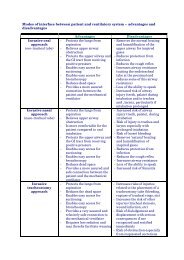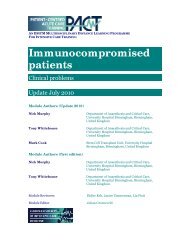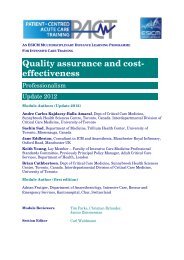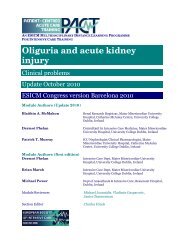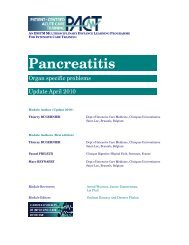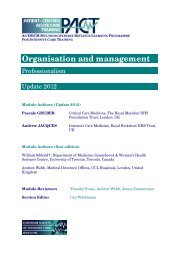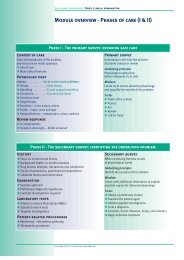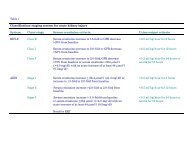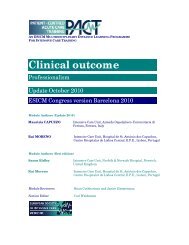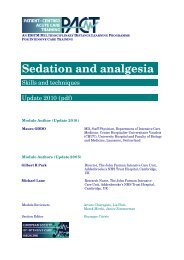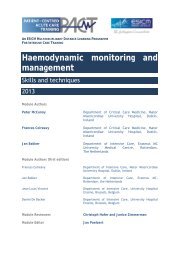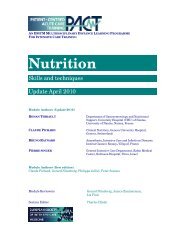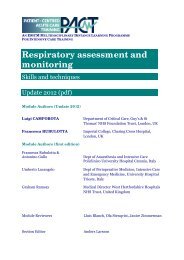Burns injury - PACT - ESICM
Burns injury - PACT - ESICM
Burns injury - PACT - ESICM
You also want an ePaper? Increase the reach of your titles
YUMPU automatically turns print PDFs into web optimized ePapers that Google loves.
Jeschke M, Norbury WB, Finnerty CC, Mlcak RP, Kulp GA, Branski LK, et al. Age<br />
differences in inflammatory and hypermetabolic postburn responses.<br />
Pediatrics 2008; 121(3): 497–507. PMID 18310198<br />
Nutritional support<br />
See the <strong>PACT</strong> module on Nutrition.<br />
Energy requirements<br />
Several predictive energy requirements equations have been developed for burn<br />
<strong>injury</strong> with the intention of preventing the acute loss of lean body mass. A typical<br />
example was the Curreri equation which has led to massive and deleterious<br />
overfeeding and these equations should be definitively abandoned.<br />
Setting an energy target in patients with major burns is challenging in the absence of<br />
indirect calorimetry. However, the Toronto equation (further detail within<br />
interactive version) based on the study of a large patient population represents a<br />
good alternative to indirect calorimetry, and includes several important factors such<br />
as the burn size (%TBSA), previous day’s feed (last 24hrs’ caloric intake = CI), Age,<br />
Sex, and Weight (derived from the predicted resting EE via the Harris & Benedict<br />
equation), fever (T o ), and time after <strong>injury</strong>.<br />
Total EE= -4.343 + (10.5 %TBSA) + (0.23 x CI) + 0.84 REE H-B) + (114 x T°C) – (4.5<br />
days)<br />
Allard JP, Pichard C, Hoshino E, Stechison S, Fareholm L, Peters WJ, et al.<br />
Validation of a new formula for calculating the energy requirements of<br />
burn patients. JPEN J Parenter Enteral Nutr 1990; 14(2): 115–118. PMID<br />
2112617<br />
Nutrition route<br />
In burns, early enteral nutrition (EN) is particularly important as it contributes to<br />
improved splanchnic perfusion during the early phase of resuscitation, prevents ileus,<br />
and attenuates the metabolic response to <strong>injury</strong>. Gastric EN should be introduced<br />
within the first 12 hrs after <strong>injury</strong>. Postpyloric feeding may be required in patients<br />
with the largest burns.<br />
Parenteral nutrition should be limited to the cases of intestinal failure with<br />
contraindication to EN. Failure is defined as the incapacity to deliver more than 60%<br />
of requirements calculated by the Toronto equation for more than four consecutive<br />
days by the postpyloric route, which is extremely rare in burn patients, who tolerate<br />
feeding rates up to 150 mL/hr for ‘catch up’ feeding after interruptions such as<br />
after repeated daily surgical procedures.<br />
30



